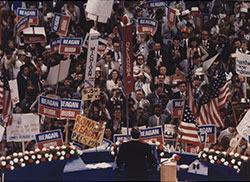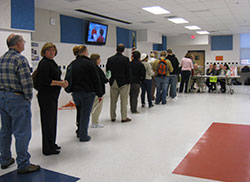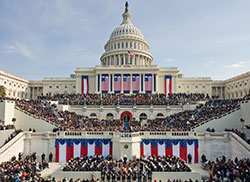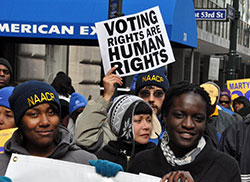Civics: Elections
Voting ![]() Election Process
Election Process ![]() Voting Rights
Voting Rights ![]() Kids Vote
Kids Vote

Voting
Citizens of democratic countries consider voting one of their chief rights because it allows them to choose who will govern them. People vote on many issues besides elections for public officials. For example, they may vote on whether to build a school, expand the police force, or impose a tax.
Who May Vote?
In Utah to register and vote you must meet the following criteria:
- Be a citizen of the United States
- Be a resident of Utah at least 30 days before the next election
- Be at least 18 years old by Election Day
Not too long ago only white, male, property owners could vote in America. Go to the History of Voting Rights section to learn how voting laws changed over the last 225 years.
Voter Registration
 Registration is the process by which a person's name is added to the list of qualified voters. On election day, officials check each person's name against the list before they let the person vote. According to the League of Women Voters of Utah web site, Utahns can register to vote:
Registration is the process by which a person's name is added to the list of qualified voters. On election day, officials check each person's name against the list before they let the person vote. According to the League of Women Voters of Utah web site, Utahns can register to vote:
The election office will notify applicants when their application has been approved and where to vote. In Utah you must register 20 days before the general election. Contact the appropriate Utah County Clerk Office with specific registration questions.
Voting Districts
In the United States, each county, township, or ward of a state is divided into voting districts called precincts. Citizens may vote only at the polling place in the precinct in which they live. Visit the Registered Voter Lookup web page to find the address of your polling place.
Absentee Voting
All registered voters can submit an absentee ballot application if they would like to vote by mail. To become a permanent absentee voter, check "Yes" in the permanent absentee section of the application.

Election Process
 The Constitution of the United States requires that a congressional election be held every two years. At that time, voters elect all the members of the House of Representatives for a two-year term and about one-third of the Senate members for a six-year term. The Constitution also requires the election of a President and a Vice President every four years. The process of becoming the president of the United States involves many steps and a lot of money. After deciding to run for president, one of the first steps is to win in a primary election.
The Constitution of the United States requires that a congressional election be held every two years. At that time, voters elect all the members of the House of Representatives for a two-year term and about one-third of the Senate members for a six-year term. The Constitution also requires the election of a President and a Vice President every four years. The process of becoming the president of the United States involves many steps and a lot of money. After deciding to run for president, one of the first steps is to win in a primary election.
Primary Election
In a primary election, a political party basically holds an election among its own members to select the party members who will represent it in the coming general election. Any number of party members can run for an office in a primary, but only the winning candidate can represent the party in the general election. Parties learn from the primary votes which candidates the members of their parties prefer. Presidential primary elections are held early during the election year.
National Conventions
 The
two major U.S. parties, the Democrats and the Republicans,
hold national conventions to officially select their nominees
for president and vice president. Usually these conventions
are held about 3 months before Election Day. Visist
the sites of the National
Republican Committee and the National
Democratic Committee to learn about the committees that
organize these conventions.
The
two major U.S. parties, the Democrats and the Republicans,
hold national conventions to officially select their nominees
for president and vice president. Usually these conventions
are held about 3 months before Election Day. Visist
the sites of the National
Republican Committee and the National
Democratic Committee to learn about the committees that
organize these conventions.
Campaigning
For eight to ten weeks between the Convention and Election Day, the Presidential and Vice-Presidential candidates campaign. The candidates state their thoughts on the party platform and make promises on behalf of the government. They also make speeches and appear at rallies and debates to present their philosophies and views on current issues.
Campaign funds are necessary to pay personnel and to finance advertising, travel, and other needs. Recently, campaign costs have become enormous. As a result, parties and candidates need to raise many millions of dollars. The majority of candidates raise most of their funds by soliciting donations from supporters, associates, and friends, and from members of their own family. Do you know how much an individual can contribute to a presidential campaign?
Put on your campaign manager hat and complete these campaign advertising activities.
Check out the presidential campaign memorabilia of past presidents. I bet you can come up better slogans than:
Election Day
 Election
Day is always the first Tuesday after the first Monday in
November. The 2006 election will be November
7.
Election
Day is always the first Tuesday after the first Monday in
November. The 2006 election will be November
7.
In the United States the people do not elect the president and vice president directly. The framers of the Constitution thought it would be impossible for such a widely scattered nation to learn anything about candidates from other states. They solved this problem by setting up the Electoral College.
This is how the Electoral College works:
- Each political party in a state nominates a list of electors. The electors are not expected to use their own judgment, but instead to vote automatically for their party's nominee for president and vice president.
- Each state has as many electors as it has Senators and Representatives. Utah has five electors (2 senators plus 3 representatives.) The District of Columbia, which has no voting representation in Congress, has three electoral votes.
This U.S. map shows the number of electoral votes each state has as a result of the 1990 census.
- List the top ten states with the largest number of electoral votes.
- How many electoral votes do they have combined?
- Is this enough to determine a presidential election?
- How much impact does Utah have in a presidential election?
- On Election Day voters throughout the nation go to the polls to choose the electors in their states. In many states the names of the electors do not even appear on the ballot. The voters see only the names of the candidates for president and vice president. Nevertheless, voters who favor the Republican (or Democratic) candidate for president actually vote for the Republican (or Democratic) electors in their state. This voting of the people for electors is called the popular vote.
- The candidate who receives the most popular votes wins all the electoral votes in a state. The other candidates get none. (Ex: In the 1996 election, Bill Clinton / Al Gore were running against Bob Dole / Jack Kemp. In Utah, Dole / Kemp received more popular votes, and therefore all 5 of Utah's electoral votes went to them.)
- On the first Monday following the second Wednesday in December, the 538 electors meet and officially vote for president and vice president. To be elected president, a candidate needs a majority of all the electoral votes in the country, 270 out of 538.
Go to the National Archives web site to view the electoral vote totals for each election. You can also see the 1996 and 1992 Electoral Votes and Electors, by State.
Presidential Inauguration
 The inauguration is the ceremony of installing the new or reelected president in office. It is held at noon on January 20 after the election. During the inauguration ceremony the new president takes the oath of office from the chief justice of the United States. With right hand raised and left hand on an open Bible, the new president says: "I do solemnly swear that I will faithfully execute the office of President of the United States, and will to the best of my ability, preserve, protect and defend the Constitution of the United States." Test your inauguration knowledge with this online quiz.
The inauguration is the ceremony of installing the new or reelected president in office. It is held at noon on January 20 after the election. During the inauguration ceremony the new president takes the oath of office from the chief justice of the United States. With right hand raised and left hand on an open Bible, the new president says: "I do solemnly swear that I will faithfully execute the office of President of the United States, and will to the best of my ability, preserve, protect and defend the Constitution of the United States." Test your inauguration knowledge with this online quiz.
Below are web resources to help you learn more about the political parties and elections.
- Federal Election Commission
- League of Women Voters
- Common Cause
- Project Vote Smart
- The Democratic National Committee
- The Republican National Committee

Voting Rights
 During colonial times, the right to vote was limited to adult white males who owned property. Most women could not vote, though some colonies gave the vote to widows who owned property. After the United States became an independent nation, the Constitution gave the states the right to decide who could vote. One by one, the states abolished property requirements and, by 1830, all white male adults could vote.
During colonial times, the right to vote was limited to adult white males who owned property. Most women could not vote, though some colonies gave the vote to widows who owned property. After the United States became an independent nation, the Constitution gave the states the right to decide who could vote. One by one, the states abolished property requirements and, by 1830, all white male adults could vote.
Since the 1800's, democratic nations have extended suffrage (the right to vote) to many people. The Constitution of the United States has been amended several times for this purpose.
- The 15th Amendment was adopted in 1870, five years after the American Civil War ended. It prohibited the states from denying a citizen the right to vote because of race.
- Women were not allowed to vote in most states until the ratification of the 19th Amendment in 1920.
- The 23rd Amendment, ratified in 1961, gave citizens living in Washington, D.C., the right to vote in national elections.
- In 1971, the 26th Amendment lowered the voting age to 18 for all state and national elections. Before then, only 10 states had allowed citizens under age 21 to vote.
African American History Resources
- The African American Odyssey: A Quest for Full Citizenship - The story of African Americans from the end of slavery through the Civil Rights era. It includes documents, maps, films and recordings.
- The First Vote - A portrayal of the first black man to vote
- African American History Challenge
Woman Suffrage Resources
- Woman Suffrage and the 19th Amendment - Primary sources, activities, and web sites for educators and students
- Votes for Women - Library of Congress' collection of books, pamphlets and other artifacts documenting the National American Woman Suffrage Association's campaign for women's right to vote.
- "Votes for Women" Suffrage - Pictures from 1850 to 1920

Kids Vote
According to the U.S. Census, only 32% of eligible eighteen to twenty-four year olds exercised their right to vote. Something must be done to turn the tide. We must work towards securing democracy for the future by involving youth in the election process today. Here are some online resources that educate, as well as involve young people in the voting process.
- Rock
the Vote - Founded in 1990, Rock the Vote is dedicated
to protecting freedom of speech, educating young people
about the issues that affect us, and motivating young people
to participate by registering, voting, and speaking out.
- Kids
Voting USA - This is a nonprofit, nonpartisan, national
program that is followed in many schools. It has its own
curriculum and encourages parents to take their children
to the polling place with them when they vote on Election
Day.
- Project
Vote Smart - You will find facts on candidates and elected
officials, including biographies, addresses, issue positions,
voting records, campaign finances, and evaluations by special
interests.
- Elections
in American Memory - This online Library of Congress
collection reviews the history of voting in America, with
links to source documents such as political posters and
recorded debates.
- The PBS Kids Democracy Project - Learn how the government affects you or what is would be like to be the President for a day.


 UTAH EDUCATION NETWORK
UTAH EDUCATION NETWORK

 Justin
Justin Braxton
Braxton Dani
Dani Kayla
Kayla Katie
Katie Lora
Lora Rob
Rob Val
Val

